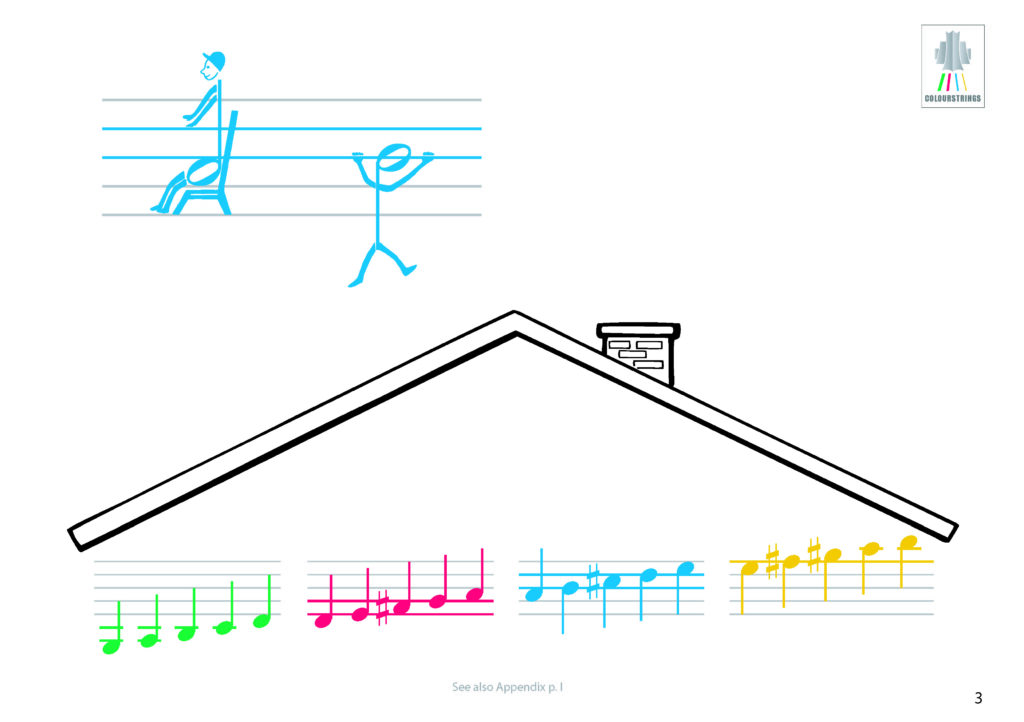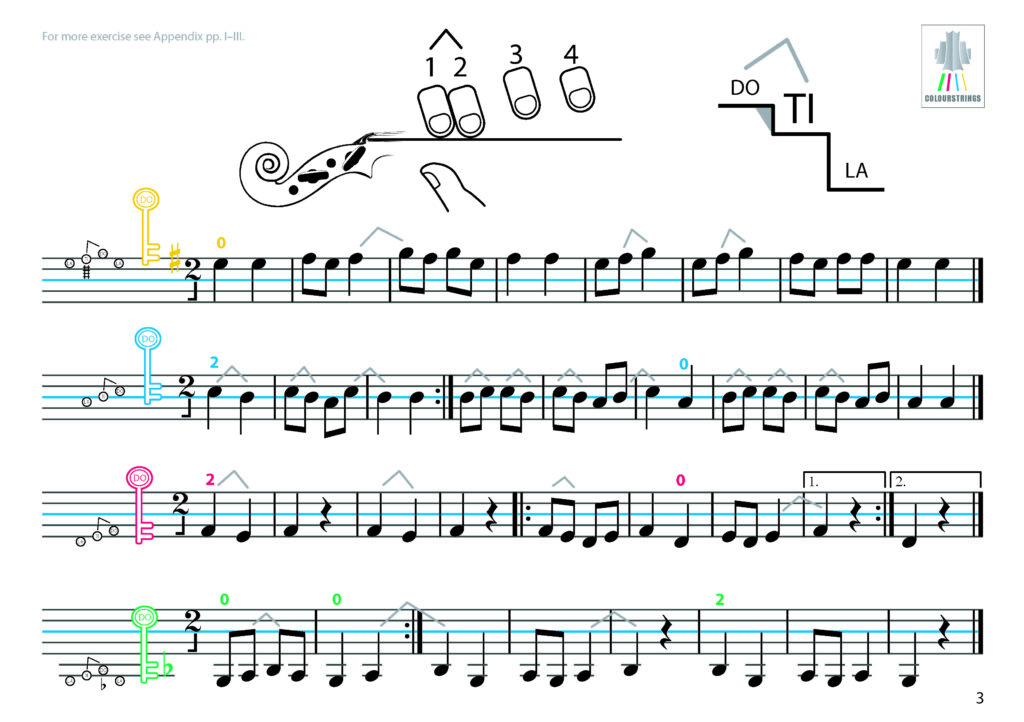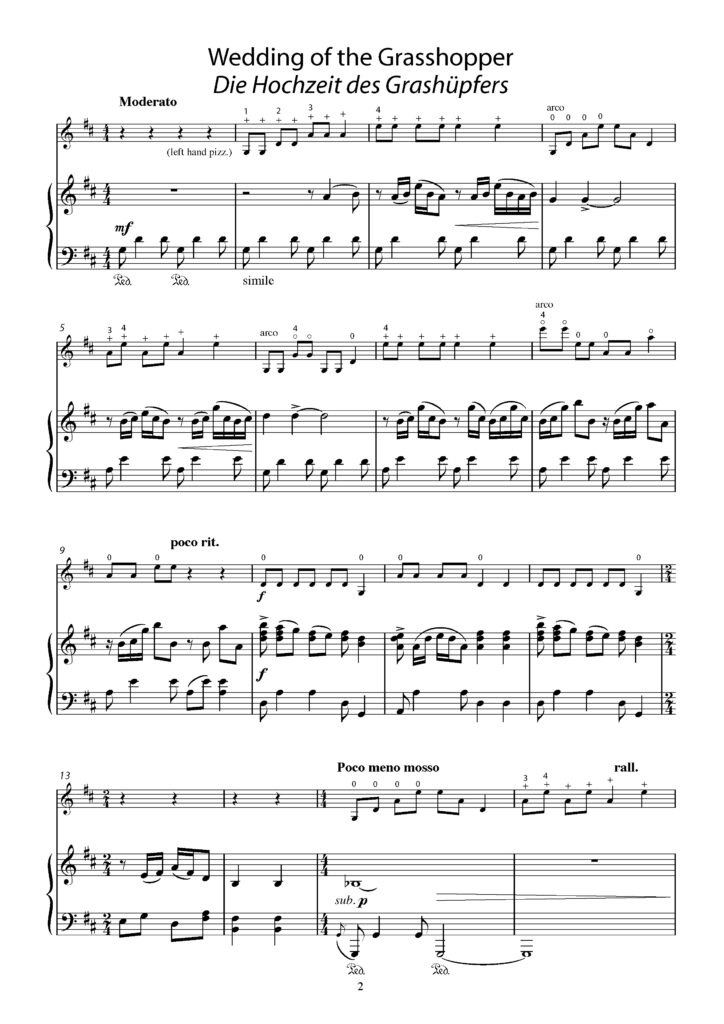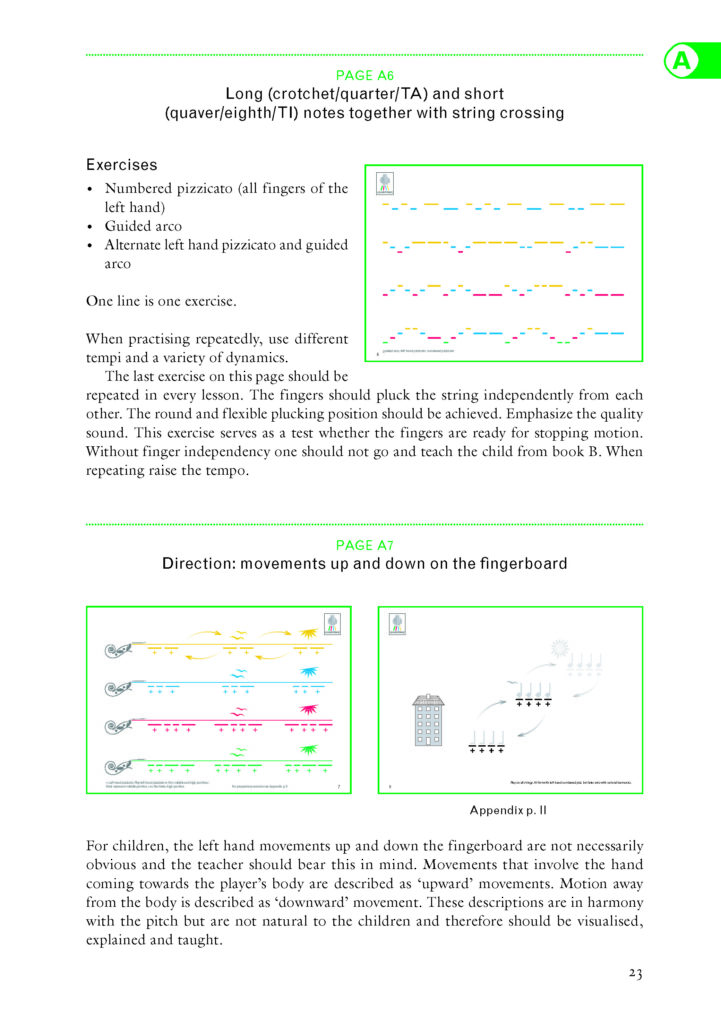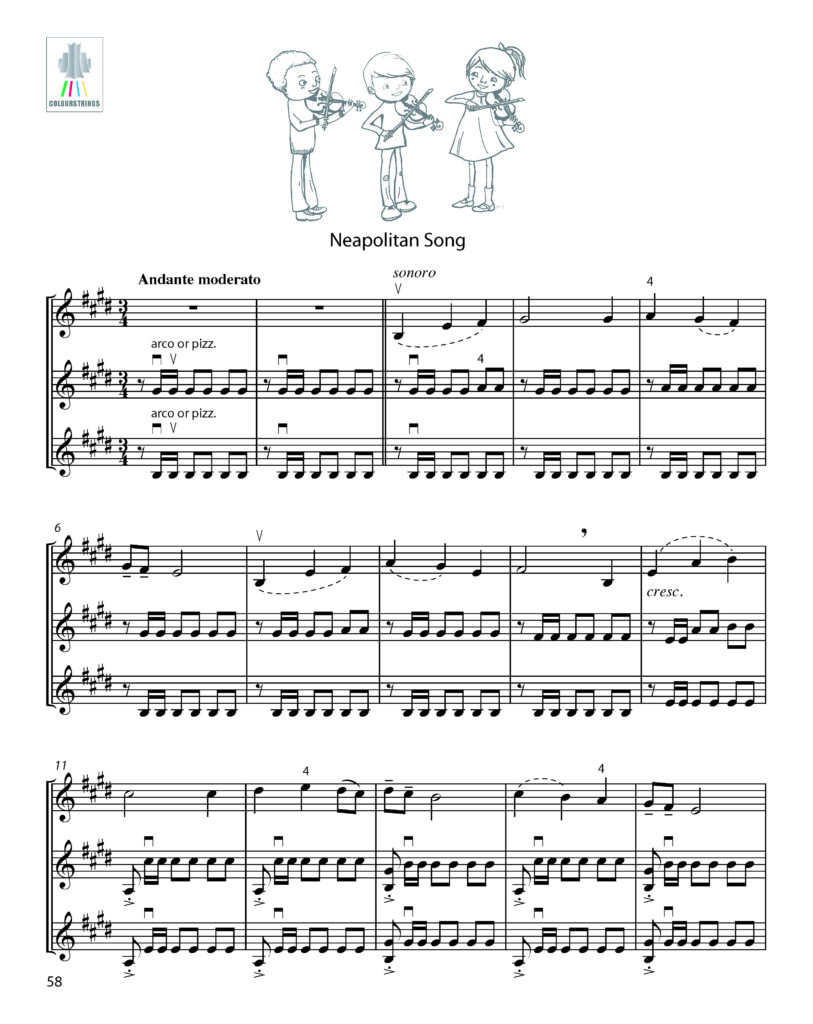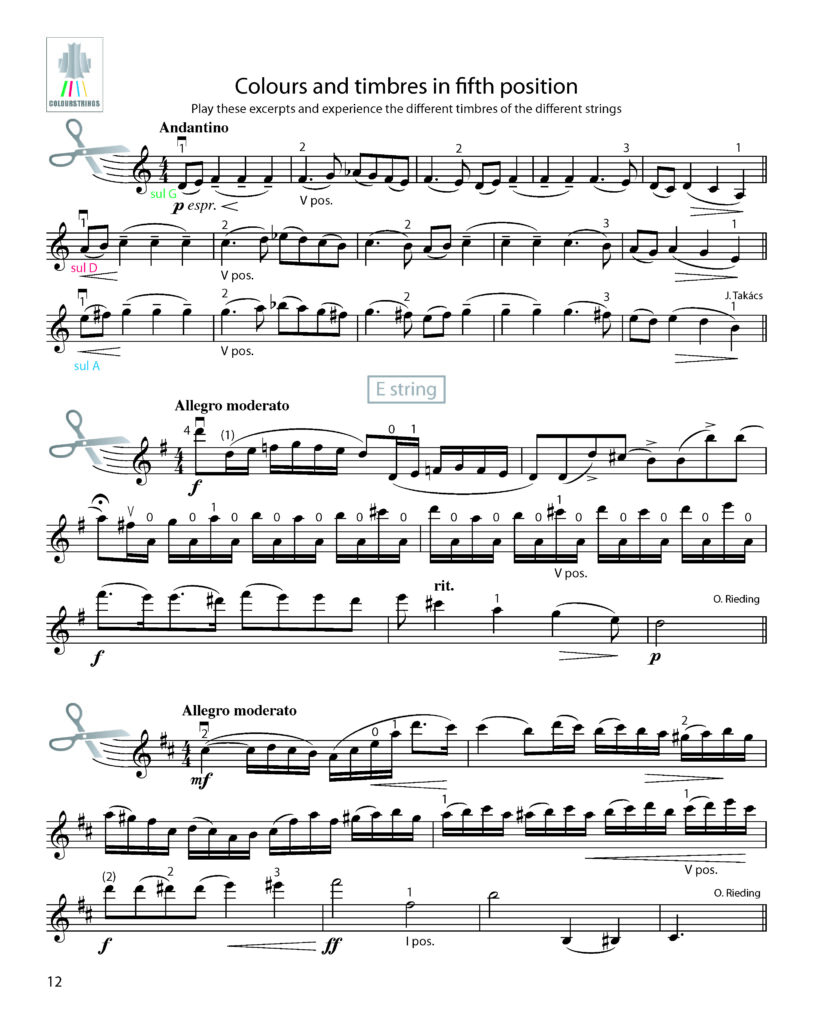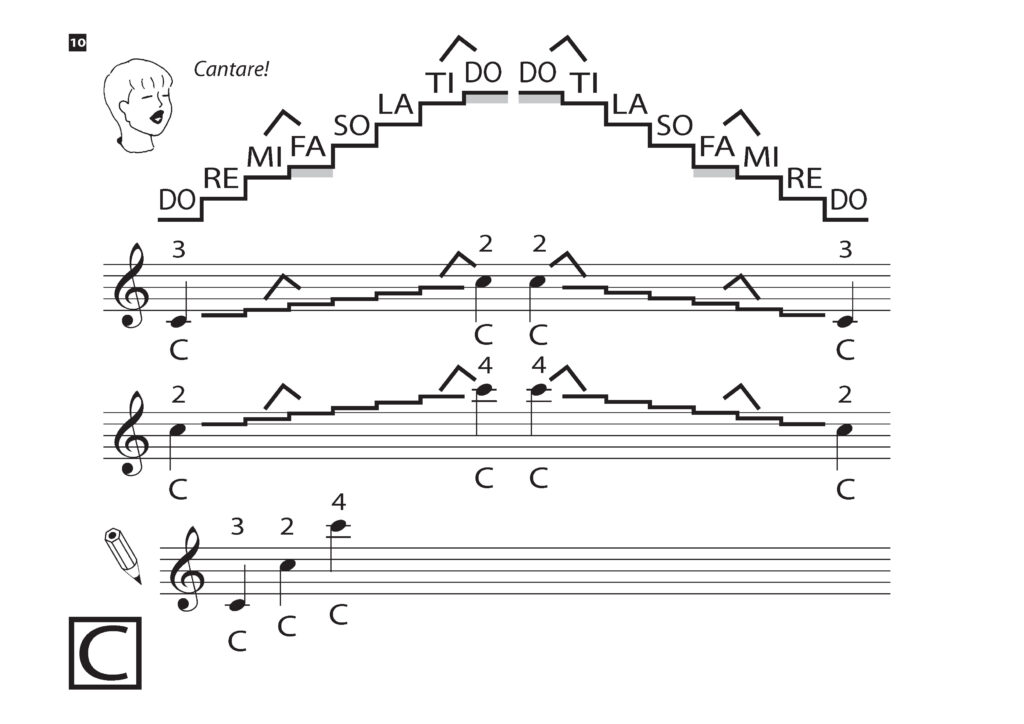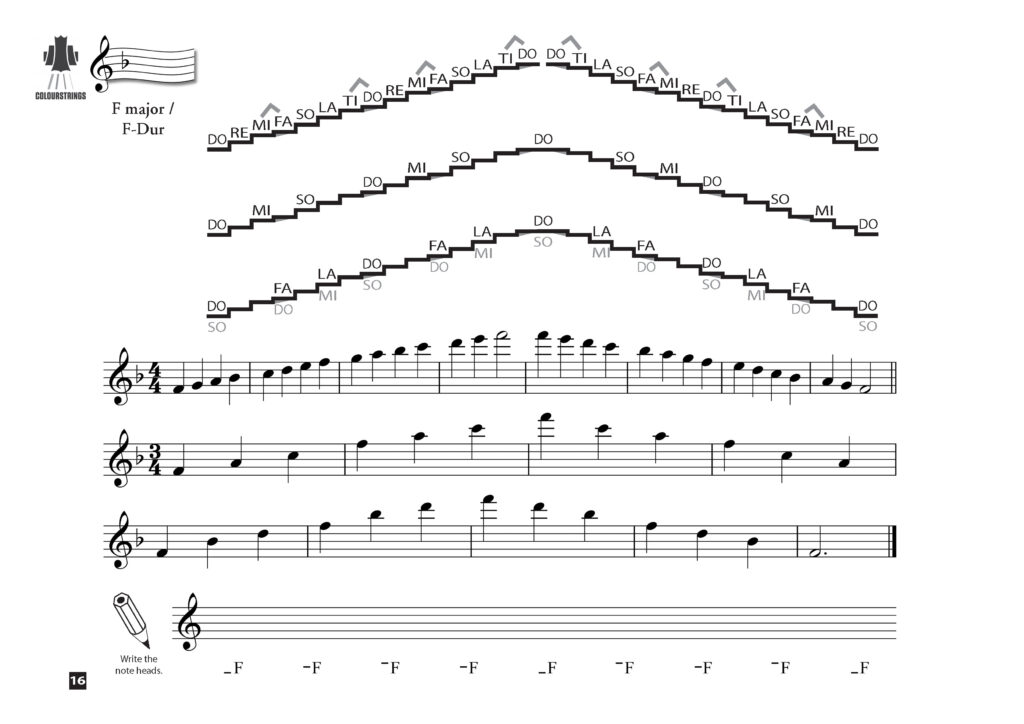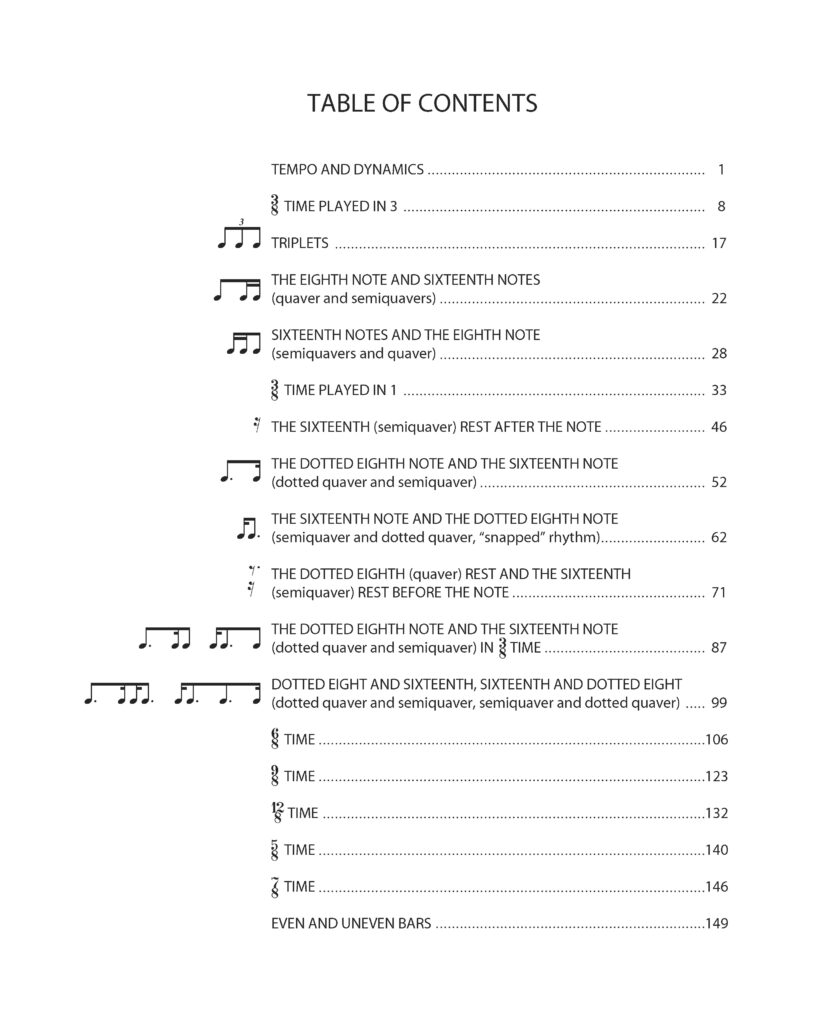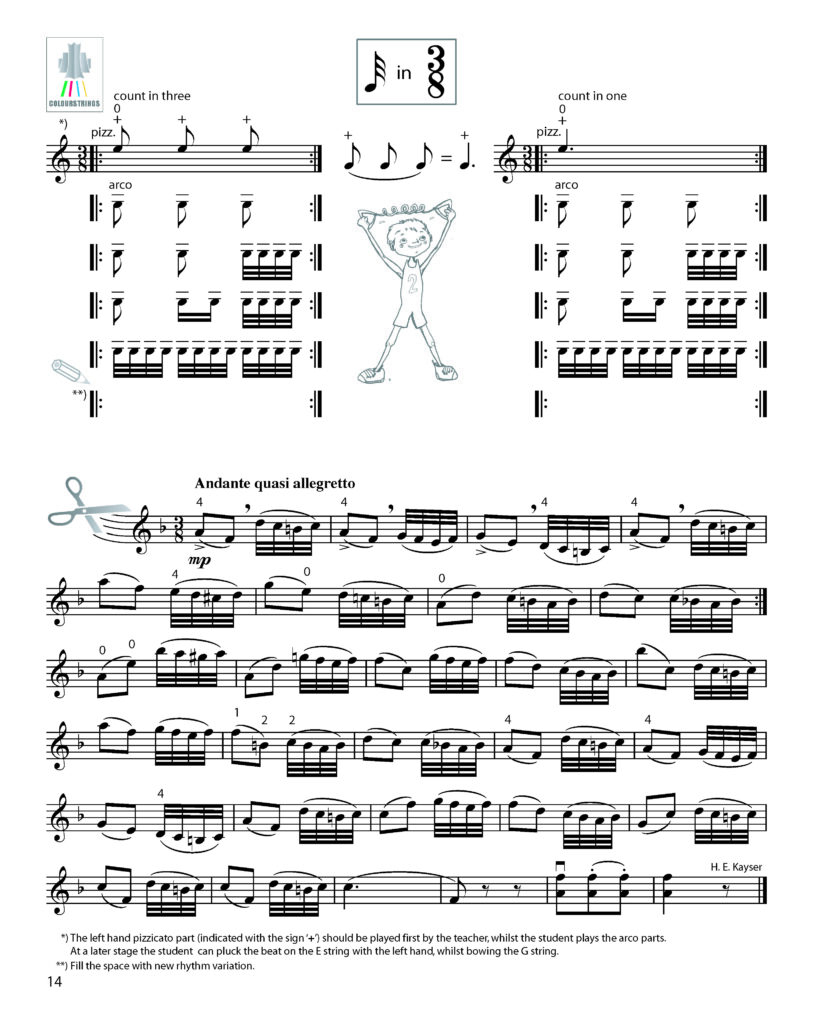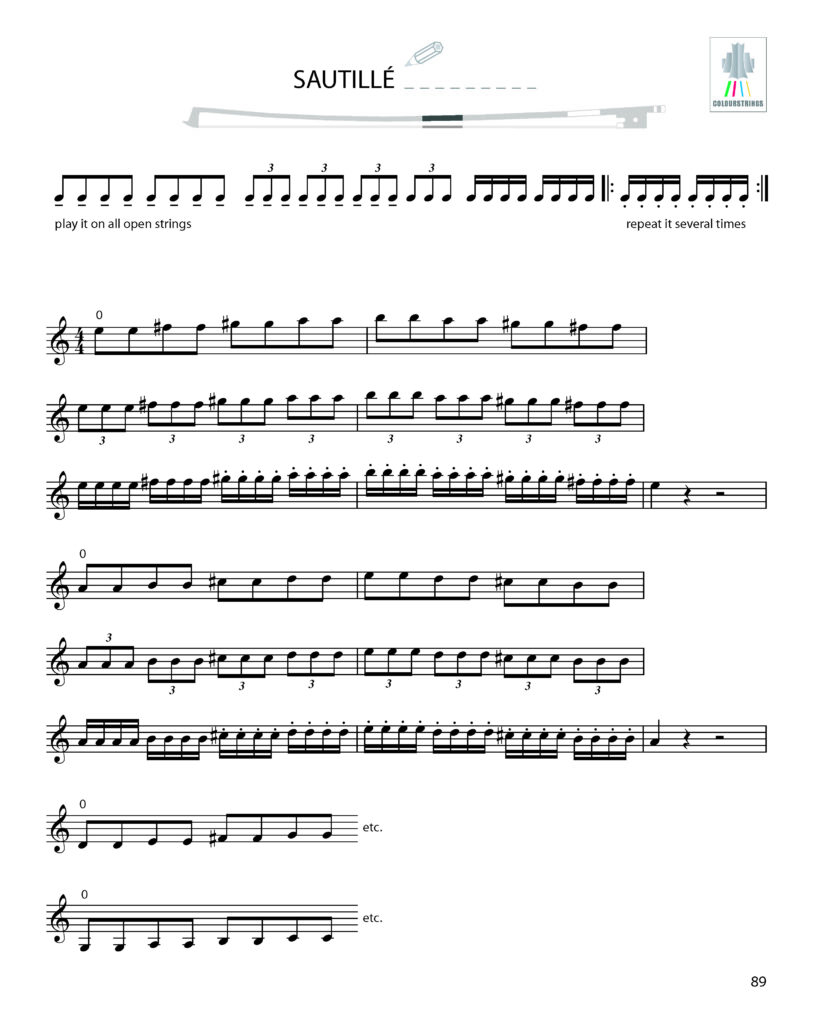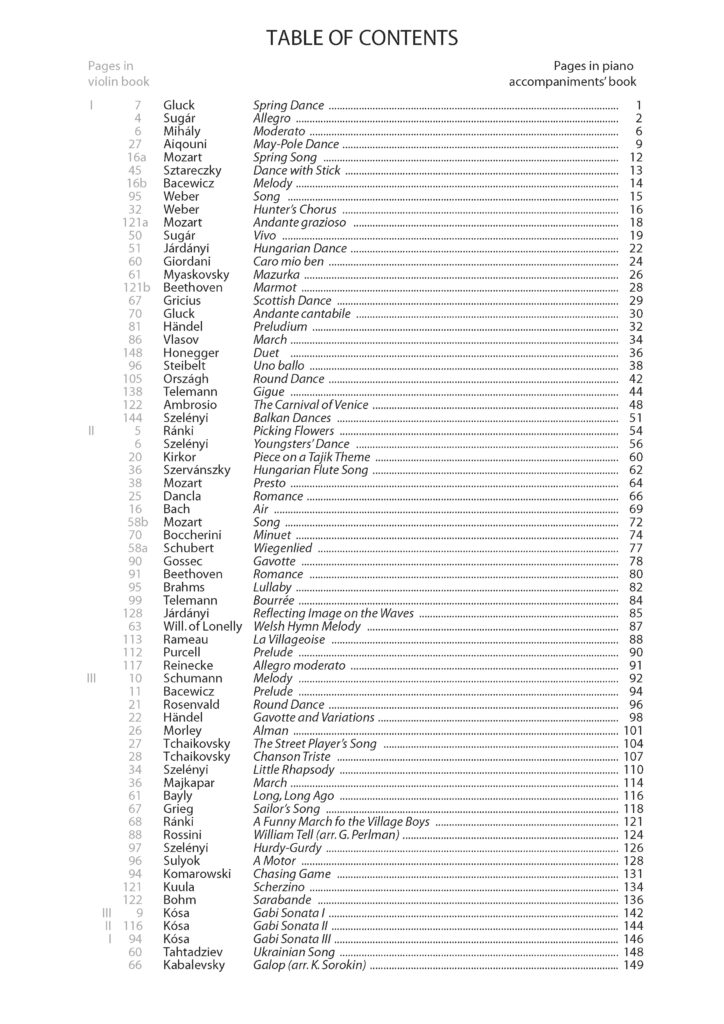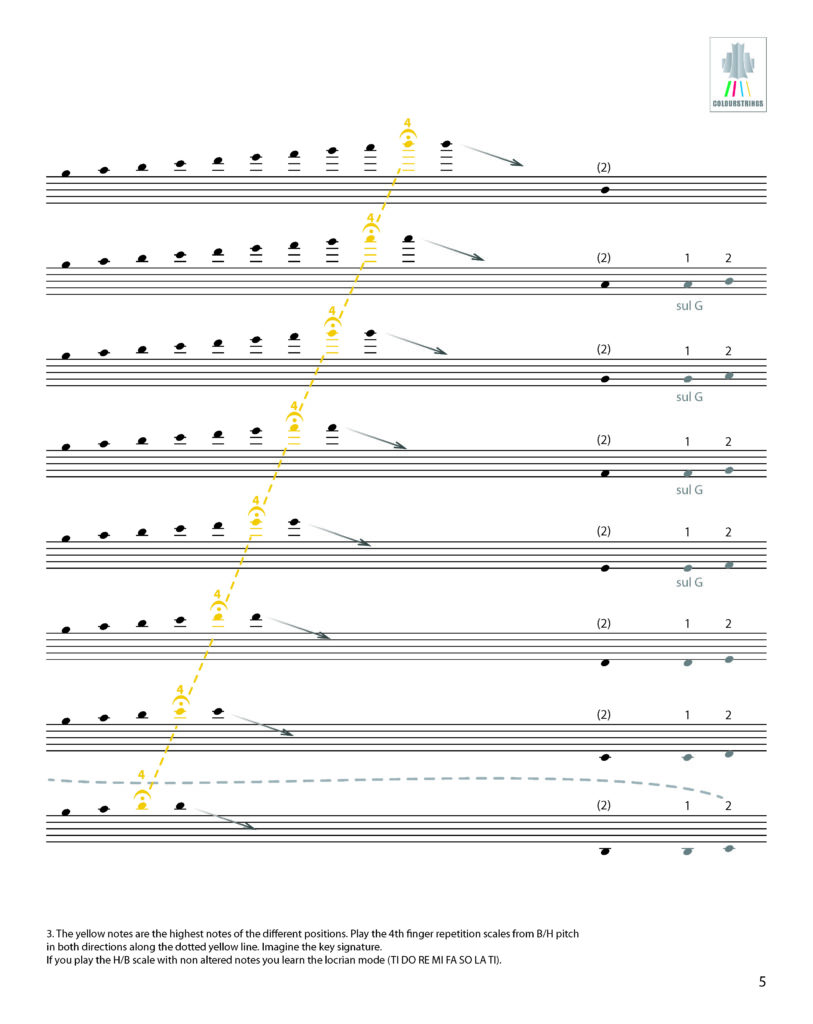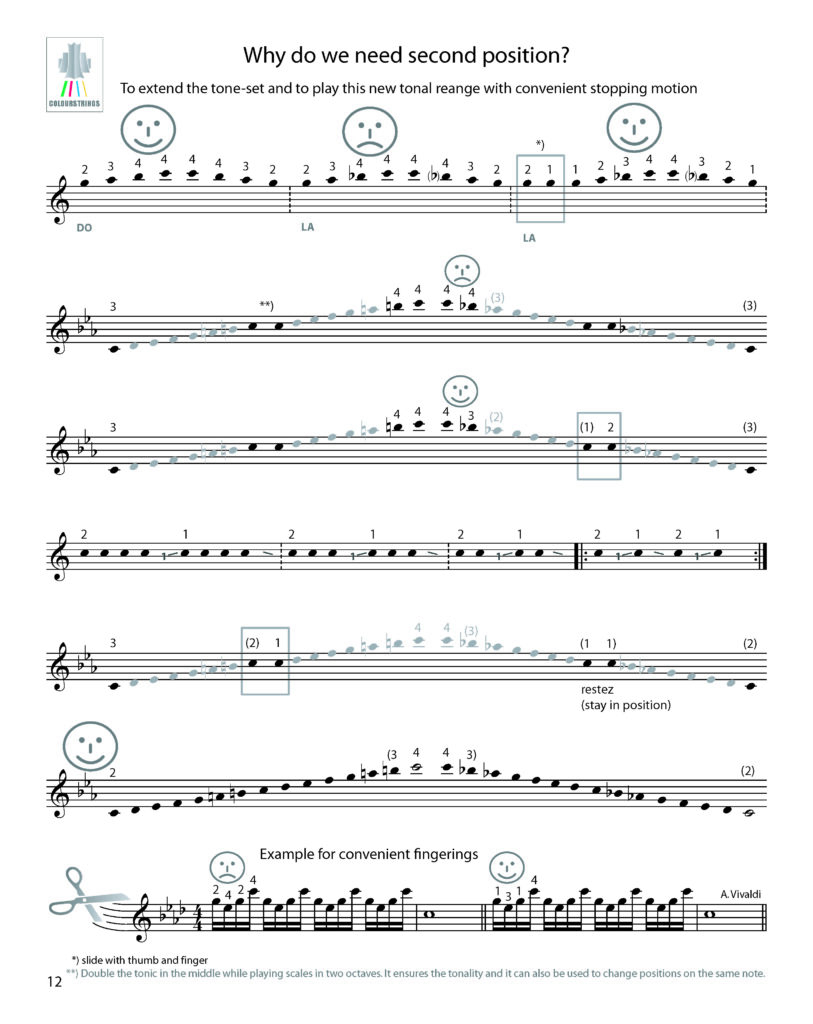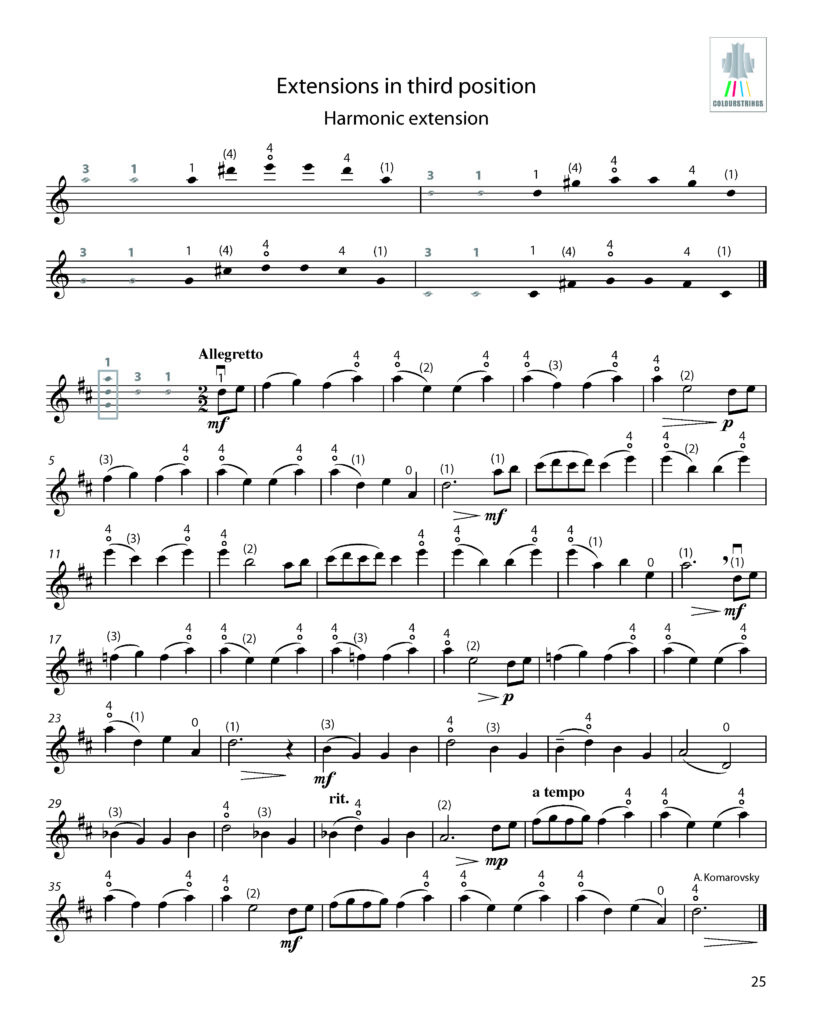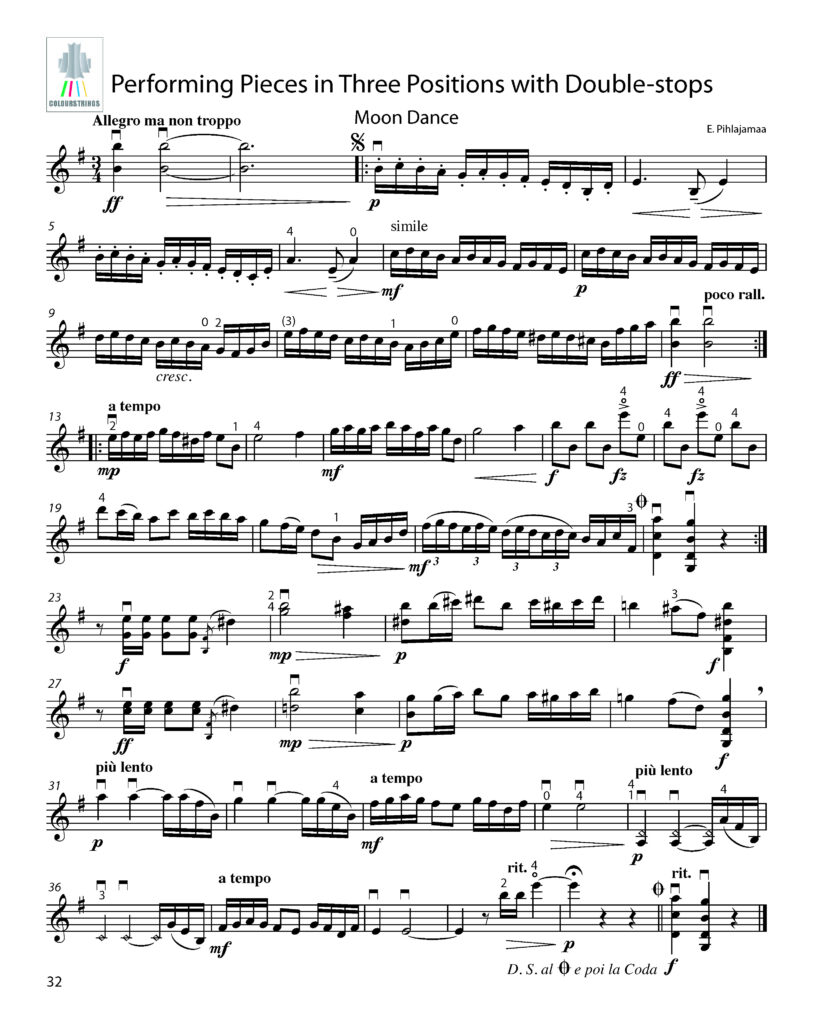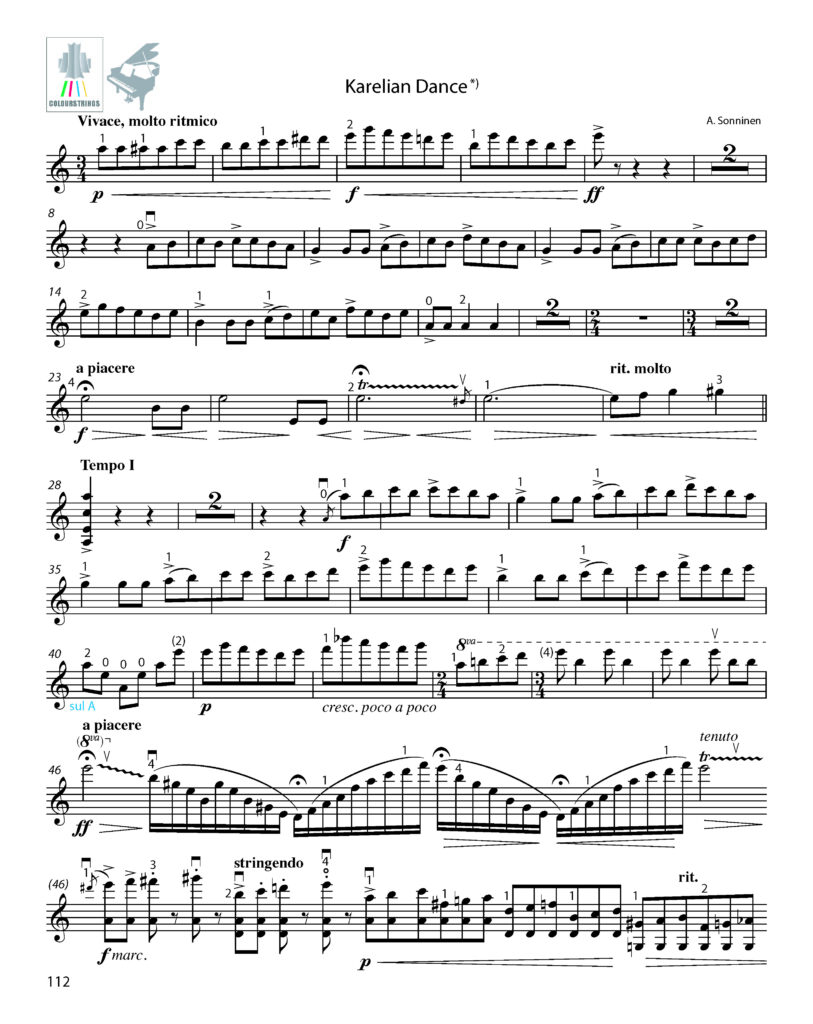From visual representations towards the five-line stave
The Colourstrings violin tutors by Géza Szilvay are designed for children aged from four years. The strings are symbolized by four characters and different colours.
Suitable also for group teaching they make music reading easy right from the start, and additional material brings along chamber music (Duettini for two violins) and performing pieces (Sonatini for violin and piano) from the very beginning.
The Handbook for Teachers and Parents guides with detailed, page to page structure through the Colourstrings Violin ABC books A, B, C & D and further. The Handbook also includes the melodies for exercises in the books A-D.
The Colourstrings Violin ABC: Book A teaches the basic positions of the violin and bow and basic movements on the violin utilizing the relative solfa system.
Left-hand “numbered pizzicato” prepares all fingers for stopping motion, and the use of natural harmonics teaches the left hand optimal, relaxed position.
The Colourstrings Violin ABC: Book B teaches how to use the stopping fingers. The child has already been taught how to play a natural harmonic, where the finger touches the string gently.
A stopped note is achieved by stopping the string sufficiently firmly. Pentachord melodies and basic rhythms expand the materials presented in the Book A, which can be continually revisited during the use of the Book B.
Kreutzerini for violin consists of 42 finger exercises (children’s songs) for perfect intonation in the first position.
These mini-studies for violin were created to make learning and teaching “ear-led finger-stopping movements” even more effective and enjoyable with inventive and resourceful use of natural harmonics and left-hand pizzicatos.
The Colourstrings Violin ABC: Book C integrates the two-line system used in the Books A and B into the five-line stave.
New rhythms, bow divisions, slurs, shifting, and double stops are combined with pentachord and pentatonic melodies. The string crossing movement is raised to a conscious level.
Colourstrings Violin ABC: Book D continues the use of the five-line stave introduced in the Book C and uses folk songs from 12 different countries.
Book D introduces new and mixed finger pattern (e.g., the flattened second finger) and major & minor pentachords as well as major and natural minor melodies by learning one new thing at a time.
An extensive appendix offers 40 pages of exercises in bow division, rests, bouncing bow, arpeggios and chords.
Easy concert pieces and chamber music repertoire
Colourstrings chamber music repertoire can be fully utilized also without any previous use or knowledge about the Colourstrings method.
Duettini for two violins by László Rossa and Géza Szilvay is used alongside with the Books A and B. It brings along chamber music from the very beginning.
In these 15 miniature duos the easy first violin part is taken from the Book A and consists of only open strings and natural harmonics. The first violin part is to be played by the beginner, whilst the second violin part is intended for an advanced pupil or the teacher.
To aid the reading the first violin part appears with child-friendly coloured and large notation, as well as with traditional notation.
Sonatini for violin and piano by László Rossa and Géza Szilvay presents 17 concert pieces with compelling piano part.
The melodies of the violin part are taken from the four first volumes of the Colourstrings Violin ABC (Books A-D). The violin part is printed in two ways: with child-friendly coloured and large notation and with traditional notation.
The piano accompaniment book is available separately.
Handbooks for teachers and parents
Colourstrings Violin ABC: Handbook for teachers and parents brings together the Colourstrings series for the violin.
With its 304 pages the Handbook guides the teachers and parents through the books A-F and Yellow Pages I-III, offering expert advice and methodological support page by page to teaching in Colourstrings method. It includes the original melodies of the exercises to be played by teacher. The lyrics of the children’s songs used in the books A−D are included too.
There are handbooks available also in German, French, Italian, Finnish and Hungarian . These editions cover the Colourstrings books A−D.
Focus on the left hand
From the Book E onwards the Colourstrings violin tutors use the standard notation. They are suitable for all the violin students and pedagogues, also without Colourstrings method background. Colourstrings Violin ABC: Handbook for Teachers and Parents guides through the following books as well, offering valuable insight.
The Colourstrings Violin ABC: Book E concentrates on the left hand and makes conscious use of the various finger patterns and finger positions on the fingerboard. In 176 pages etudes and exercises alternate with excerpts from the violin literature, folk music, duos, and trios. The book E also contains 21 performance pieces from 16 composers, from Bach and Rameau to Schumann and Tchaikovsky. Hungarian(https://webshop.fennicagehrman.fi/page/product/colourstrings-hedeg-abc-ke-zikonyv-tan-roknakes-sz-loknek/104997). These editions cover the Colourstrings books A−D.
Colourstrings Violin ABC: Book F (120 pages, including 20 performance pieces from 17 composers) is divided to sections titled as Special positions of the stopping fingers (eg. half position), Chromaticism, Enharmonics, Playing on two strings, Double stops, and the Modes.
Colourstrings Violin ABC, Piano Accompaniments for Books E & F is available separately.
Violin scales for children 1 introduces the major and natural minor scales.
To facilitate the learning, each page will introduce only one new note. The initial tone of each scale is properly printed; the places of other tones are illustrated with a diagram. This helps the child to concentrate on the learning and writing of the new note and its locating on the fingerboard.
In Violin Scales for Children 2 the pupils become acquainted with chromatically altered tones and with major and natural minor scales based on them.
The chromatic scale is introduced at the end of the book.
Scales and Arpeggios for Children 3 uses tonic solfa to acquaint the pupil with major and melodic minor scales and major and minor arpeggios, played over one and two octaves.
In the scales over two octaves, the lenght of the last note in both directions—ascending and descending—is doubled to allow the player to gain a secure feeling for the tonic.
The directories for rhythms, ornaments, and bow techinques
The title Yellow Pages refers to the yellow telephone directories that list important services. In the same way, the Yellow Pages of the Colourstrings violin school offer specific pedagogical advice to violin teachers and their students. Consisting of introduction, etudes, folk music, excerpts from the literature, chamber music and performance pieces, the three volumes of Yellow Pages are designed to teach and develop the feeling of pulse, to assist in the mastering of all rhythms and their combinations, to explain the function of time signatures, to help build a basic knowledge of ornaments and to create a solid basis for virtuosic bow technique.
Yellow Pages Book I: Basic Rhythms is designed to teach and develop the feeling of pulse, to assist in the mastering of all rhythms and their combinations and to explain the function of time signatures. The chapters concentrate on one rhythm or time signature at a time and are divided to introduction, etudes, folk music, excerpts from the literature, chamber music (18 duos for two violins) and 25 performance pieces with piano accompaniment.
Yellow Pages Book II: Basic Rhythms and Ornaments teaches the change of the time signature, various syncopated rhytms, augmentation, double dots, and playing the off-beat among others.
Ornamentation (appoggiatura, mordent, trill etc) is practiced with excerpts from the violin literature. Also exercises of vibrato are included. alongside with 19 performance pieces with piano accompaniment.
”Violin playing could be introduced as magical and the bow for instance could be compared to a magic paintbrush, which paints beautiful pictures, performs and tells interesting stories or whispers secret feelings.”
Yellow Pages Book III: Basic Bowings uses alongside the traditional classification of bowings and bowingnames definitions, which were invented by the children.
Détaché, legato, portato, martelé, staccato, marcato, spiccato, ricochet, sautillé and arpeggios included, additional pedagogical observations can be found in the Colourstrings Violin ABC: Handbook for Teachers and Parents.
Yellow Pages of the Colourstrings Violin School – Piano Accompaniments includes in one volume all the piano accompaniments of the three Yellow Pages Books.
One book for each position: exercises, chamber music and performance pieces
The G1-G5 Books of the Colourstrings violin method study every position of the violin in a separate volume. These books form an all-embracing, rich collection of shifting exercises, position playing studies, excerpts from the literature, chamber music (mainly duos), and performing pieces, piano accompaniment offered as a separate publication. The G books follow the key principles of Colourstrings methodology – the use of natural harmonics for instance – but it can be fully utilized also without any previous use or knowledge about the Colourstrings method.
The innovative and unique visual presentation of the “house of the positions” and preparatory exercises for the challenging passages help the young and older students to fully understand, why and where the different positions are needed.
The volume G of the Colourstrings violin tutors serves as a source for performance and chamber music repertoire.
Colourstrings Violin ABC: Book G1 – Second position studies the second position by setting a stationary base finger, examining intervals, and various keys, making shifting exercises between the first and the second position.
The exercises and excerpts from the literature make student understand, how to create convenient fingerings in different situations.
Colourstrings Violin ABC: Book G2 -Third position highlights the different shifting situations between the first, the second and the third positions: on the same note, after open string, with the same finger, from higher finger to lower finger.
Performing pieces for Violin in the First Three Positions (Supplement for Book G2) can be used individually as a repertoire book as well.
Piano accompaniments of the books G1, G2 and Performing pieces are included in Colourstrings Violin ABC: Piano accompaniments for the books G1, G2 & G2 supplement.
In all the G Books, there are several duos for two violins. Colourstrings Violin ABC: Book G3 – Fourth position offers also a wealth of double-stop exercises and performance pieces.
Different positions change the timbre – the goal is not only master the shifting movements but also to understand why and when to use a particular position. Colourstrings Violin ABC: Book G4 – Fifth position pays attention to this too.
Colourstrings Violin ABC: Piano accompaniments for the books G3 & G4 includes the piano part for 26 performance pieces from Brahms, Prokofieff and Wieniawski among others.
The repertoire and the exercises in Colourstrings Violin ABC: Book G5 – Sixth and seventh positions complete the substantial Colourstrings Violin series with content, after which the professional studies can begin.
The piano accompaniments of the Book G5 are available as a separate volume.




